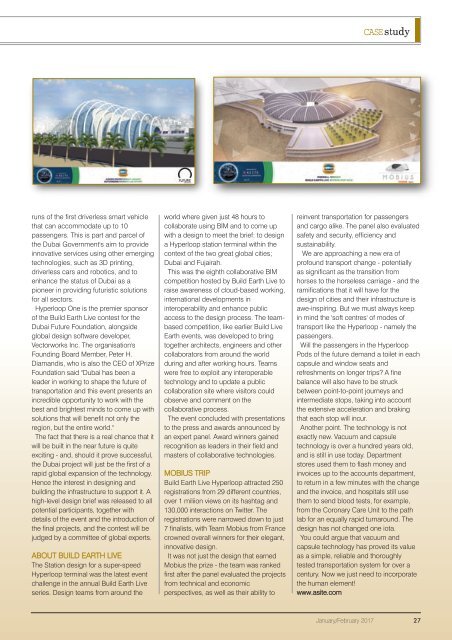CC3001
You also want an ePaper? Increase the reach of your titles
YUMPU automatically turns print PDFs into web optimized ePapers that Google loves.
CASEstudy<br />
runs of the first driverless smart vehicle<br />
that can accommodate up to 10<br />
passengers. This is part and parcel of<br />
the Dubai Government's aim to provide<br />
innovative services using other emerging<br />
technologies, such as 3D printing,<br />
driverless cars and robotics, and to<br />
enhance the status of Dubai as a<br />
pioneer in providing futuristic solutions<br />
for all sectors.<br />
Hyperloop One is the premier sponsor<br />
of the Build Earth Live contest for the<br />
Dubai Future Foundation, alongside<br />
global design software developer,<br />
Vectorworks Inc. The organisation's<br />
Founding Board Member, Peter H.<br />
Diamandis, who is also the CEO of XPrize<br />
Foundation said "Dubai has been a<br />
leader in working to shape the future of<br />
transportation and this event presents an<br />
incredible opportunity to work with the<br />
best and brightest minds to come up with<br />
solutions that will benefit not only the<br />
region, but the entire world."<br />
The fact that there is a real chance that it<br />
will be built in the near future is quite<br />
exciting - and, should it prove successful,<br />
the Dubai project will just be the first of a<br />
rapid global expansion of the technology.<br />
Hence the interest in designing and<br />
building the infrastructure to support it. A<br />
high-level design brief was released to all<br />
potential participants, together with<br />
details of the event and the introduction of<br />
the final projects, and the contest will be<br />
judged by a committee of global experts.<br />
ABOUT BUILD EARTH LIVE<br />
The Station design for a super-speed<br />
Hyperloop terminal was the latest event<br />
challenge in the annual Build Earth Live<br />
series. Design teams from around the<br />
world where given just 48 hours to<br />
collaborate using BIM and to come up<br />
with a design to meet the brief: to design<br />
a Hyperloop station terminal within the<br />
context of the two great global cities;<br />
Dubai and Fujairah.<br />
This was the eighth collaborative BIM<br />
competition hosted by Build Earth Live to<br />
raise awareness of cloud-based working,<br />
international developments in<br />
interoperability and enhance public<br />
access to the design process. The teambased<br />
competition, like earlier Build Live<br />
Earth events, was developed to bring<br />
together architects, engineers and other<br />
collaborators from around the world<br />
during and after working hours. Teams<br />
were free to exploit any interoperable<br />
technology and to update a public<br />
collaboration site where visitors could<br />
observe and comment on the<br />
collaborative process.<br />
The event concluded with presentations<br />
to the press and awards announced by<br />
an expert panel. Award winners gained<br />
recognition as leaders in their field and<br />
masters of collaborative technologies.<br />
MOBIUS TRIP<br />
Build Earth Live Hyperloop attracted 250<br />
registrations from 29 different countries,<br />
over 1 miliion views on its hashtag and<br />
130,000 interactions on Twitter. The<br />
registrations were narrowed down to just<br />
7 finalists, with Team Mobius from France<br />
crowned overall winners for their elegant,<br />
innovative design.<br />
It was not just the design that earned<br />
Mobius the prize - the team was ranked<br />
first after the panel evaluated the projects<br />
from technical and economic<br />
perspectives, as well as their ability to<br />
reinvent transportation for passengers<br />
and cargo alike. The panel also evaluated<br />
safety and security, efficiency and<br />
sustainability.<br />
We are approaching a new era of<br />
profound transport change - potentially<br />
as significant as the transition from<br />
horses to the horseless carriage - and the<br />
ramifications that it will have for the<br />
design of cities and their infrastructure is<br />
awe-inspiring. But we must always keep<br />
in mind the 'soft centres' of modes of<br />
transport like the Hyperloop - namely the<br />
passengers.<br />
Will the passengers in the Hyperloop<br />
Pods of the future demand a toilet in each<br />
capsule and window seats and<br />
refreshments on longer trips? A fine<br />
balance will also have to be struck<br />
between point-to-point journeys and<br />
intermediate stops, taking into account<br />
the extensive acceleration and braking<br />
that each stop will incur.<br />
Another point. The technology is not<br />
exactly new. Vacuum and capsule<br />
technology is over a hundred years old,<br />
and is still in use today. Department<br />
stores used them to flash money and<br />
invoices up to the accounts department,<br />
to return in a few minutes with the change<br />
and the invoice, and hospitals still use<br />
them to send blood tests, for example,<br />
from the Coronary Care Unit to the path<br />
lab for an equally rapid turnaround. The<br />
design has not changed one iota.<br />
You could argue that vacuum and<br />
capsule technology has proved its value<br />
as a simple, reliable and thoroughly<br />
tested transportation system for over a<br />
century. Now we just need to incorporate<br />
the human element!<br />
www.asite.com<br />
January/February 2017 27

















